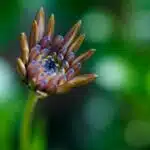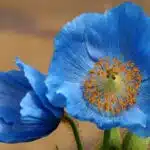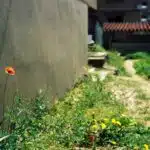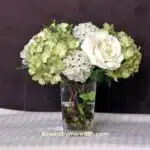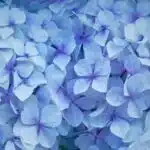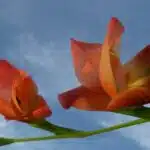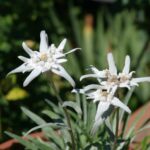If you’re looking to add a touch of whimsy to your garden, the bell flower may just be the perfect addition. Also known as campanula, these dainty flowers feature charming bell-shaped blooms in shades of blue, purple, pink, and white. But there’s more to these plants than just their good looks. They’re also easy to care for and attract pollinators like bees and butterflies. In this comprehensive guide, we’ll take a deep dive into the world of bell flowers, covering everything from their different types and uses to how to grow them in your own garden.
Types of Bell Flowers
There are dozens of different types of bell flowers, each with its own unique characteristics. Here are some of the most popular varieties:
- Canterbury Bells (Campanula medium): These biennial plants produce tall spikes of bell-shaped flowers in shades of blue, pink, and white. They’re great for adding vertical interest to your garden and make excellent cut flowers.
- Peach-Leaved Bellflower (Campanula persicifolia): As the name suggests, this type of bell flower features narrow, peach-like leaves and produces spikes of blue or white bell-shaped flowers. It’s a perennial that blooms in early to mid-summer.
- Tussock Bellflower (Campanula carpatica): This low-growing perennial produces masses of small, star-shaped blue or white flowers. It’s ideal for rock gardens, edging, or ground cover.
- Clustered Bellflower (Campanula glomerata): This perennial plant produces clusters of purple or white bell-shaped flowers in early to mid-summer. It’s great for adding color to borders or mass planting.
- Serbian Bellflower (Campanula poscharskyana): This low-growing, spreading perennial produces masses of small blue or white flowers in early to mid-summer. It’s great for ground cover, edging, or planting in rock gardens.
Uses of Bell Flowers
Bell flowers have a variety of different uses, both ornamental and practical. Here are some of the most common ways to use these charming plants:
- Ornamental plants: Bell flowers are primarily grown for their ornamental value. They’re great for adding color and texture to borders, rock gardens, and container gardens.
- Cut flowers: Many types of bell flowers make excellent cut flowers. They’re perfect for adding a touch of charm to bouquets and floral arrangements.
- Medicinal uses: Some species of bell flowers have been used in traditional medicine to treat a variety of ailments, including respiratory infections, digestive issues, and inflammation.
- Culinary uses: While not commonly used in modern cuisine, some species of bell flowers have been used in the past to add color and flavor to dishes. The flowers of Canterbury bells, for example, were once used to make a blue dye for icing.
Growing Bell Flowers
One of the great things about bell flowers is that they’re relatively easy to grow, even for novice gardeners. Here are some tips for growing these charming plants:
- Choose the right location: Bell flowers prefer a location with full sun to partial shade and well-draining soil.
- Plant at the right time: Depending on the type of bell flower you’re planting, you may need to plant in the spring or fall. Be sure to check the specific requirements for your chosen variety.
- Water regularly: Bell flowers prefer moist soil, so be sure to water regularly, especially during hot, dry weather.
- Fertilize occasionally: While bell flowers don’t require a lot of fertilizer, a light application of a balanced fertilizer in the spring can help promote healthy growth and flowering.
- Deadhead regularly: Removing spent blooms regularly can help encourage your plants to produce more flowers and extend their blooming period.
Propagating Bell Flowers
If you want to propagate your bell flowers, there are several different methods you can use:
- Seeds: Many types of bell flowers can be grown from seed. Simply sow the seeds in the spring or fall according to the instructions on the seed packet.
- Division: Perennial varieties of bell flowers can be divided in the spring or fall by carefully digging up the plant and separating the roots into smaller clumps.
- Stem cuttings: Some types of bell flowers can be propagated from stem cuttings taken in the spring or summer. Simply take a cutting from a healthy stem and root it in soil or water.
Common Problems and Pests
While bell flowers are relatively easy to grow, they can be susceptible to a few common problems and pests. Here are some of the most common issues to watch out for:
- Powdery mildew: This fungal disease can cause a powdery white coating to form on the leaves of your bell flowers. To prevent powdery mildew, be sure to plant your bell flowers in a location with good air circulation and avoid overwatering.
- Slugs and snails: These slimy pests can munch on the leaves and flowers of your bell flowers. To keep them at bay, try placing copper tape around the base of your plants or use a slug bait that’s safe for pets and wildlife.
- Aphids: These small insects can suck the sap from the leaves and stems of your bell flowers, causing them to wilt and die. To control aphids, try spraying your plants with a solution of water and dish soap or neem oil.
Bell Flower Symbolism and Folklore
Like many flowers, bell flowers have a rich history of symbolism and folklore. Here are some of the meanings and legends associated with these charming plants:
- Love and gratitude: In the Victorian language of flowers, bell flowers were said to symbolize love and gratitude. They were often given as gifts to express affection and appreciation.
- Protection: In medieval Europe, it was believed that bell flowers could protect against witches and evil spirits. It was common to hang them over doors and windows or carry them as an amulet.
- Fairy bells: In many cultures, bell flowers are associated with fairies and the magical realm. It was said that if you heard the sound of a bell flower ringing, it meant that fairies were near.
- Remembrance: In some cultures, bell flowers are associated with remembrance and honoring the dead. They were often planted on graves or used in funeral wreaths.
Bell Flower Crafts and DIY Projects
If you’re looking for creative ways to use bell flowers, there are plenty of crafts and DIY projects that you can try. Here are some ideas to get you started:
- Pressed flowers: Bell flowers are perfect for pressing and preserving. Simply place the flowers between two pieces of paper and press them in a heavy book for a few weeks.
- Floral wreaths: Use fresh or dried bell flowers to create beautiful floral wreaths for your home or to give as gifts.
- Flower crowns: Bell flowers are the perfect choice for creating whimsical flower crowns. Simply attach the flowers to a wire or ribbon base using floral wire or hot glue.
- Embroidery: Bell flowers can be used as a motif in embroidery projects, such as on a pillow or a piece of wall art.
Bell Flower Trivia
Here are some fun facts and trivia about bell flowers that you might not know:
- The name “campanula” comes from the Latin word for “bell,” which refers to the shape of the flower.
- Bell flowers are native to many different regions of the world, including Europe, Asia, and North America.
- In some parts of Europe, bell flowers were once used to make a tea that was said to cure insomnia.
- The flowers of Canterbury bells were once used to make a blue dye that was used to color icing.
- Bell flowers are often featured in art and literature, including in the works of William Shakespeare and Emily Dickinson.
Bell Flower Varieties and Characteristics
Here is a closer look at some of the most popular bell flower varieties and their characteristics:
Canterbury Bells (Campanula medium)
Canterbury bells are biennial plants that produce tall spikes of bell-shaped flowers in shades of blue, pink, and white. They are great for adding vertical interest to your garden and make excellent cut flowers. They can grow up to three feet tall and prefer full sun to partial shade.
Peach-Leaved Bellflower (Campanula persicifolia)
Peach-leaved bellflower is a perennial that produces spikes of blue or white bell-shaped flowers in early to mid-summer. It gets its name from its narrow, peach-like leaves. It can grow up to three feet tall and prefers partial shade.
Tussock Bellflower (Campanula carpatica)
Tussock bellflower is a low-growing perennial that produces masses of small, star-shaped blue or white flowers. It is ideal for rock gardens, edging, or ground cover. It grows to a height of six to twelve inches and prefers full sun to partial shade.
Clustered Bellflower (Campanula glomerata)
Clustered bellflower is a perennial plant that produces clusters of purple or white bell-shaped flowers in early to mid-summer. It is great for adding color to borders or mass planting. It can grow up to two feet tall and prefers full sun to partial shade.
Serbian Bellflower (Campanula poscharskyana)
Serbian bellflower is a low-growing, spreading perennial that produces masses of small blue or white flowers in early to mid-summer. It is great for ground cover, edging, or planting in rock gardens. It grows to a height of six to twelve inches and prefers full sun to partial shade.
Bell Flower Growing Tips
If you’re new to gardening, bell flowers are a great plant to start with. Here are some tips for growing these charming plants:
- Choose the right location: Bell flowers prefer a location with full sun to partial shade and well-draining soil.
- Plant at the right time: Depending on the type of bell flower you’re planting, you may need to plant in the spring or fall. Be sure to check the specific requirements for your chosen variety.
- Water regularly: Bell flowers prefer moist soil, so be sure to water regularly, especially during hot, dry weather.
- Fertilize occasionally: While bell flowers don’t require a lot of fertilizer, a light application of a balanced fertilizer in the spring can help promote healthy growth and flowering.
- Deadhead regularly: Removing spent blooms regularly can help encourage your plants to produce more flowers and extend their blooming period.
- Propagate: If you want to propagate your bell flowers, there are several different methods you can use, including seeds, division, and stem cuttings.
Bell Flower DIY Projects
Bell flowers are not only beautiful in the garden, but they can also be used in a variety of DIY projects. Here are some ideas to inspire you:
Bell Flower Wreath
Create a stunning wreath using fresh or dried bell flowers. Start by gathering your materials, including a grapevine wreath base, floral wire, and a mix of fresh or dried bell flowers in different colors. Arrange the flowers on the wreath base, securing them with floral wire as you go. Once you have your desired arrangement, hang your wreath and enjoy!
Bell Flower Embroidery
Use bell flowers as a motif in your embroidery projects. Start by choosing a pattern or design that incorporates bell flowers, then gather your materials, including embroidery thread, a needle, and fabric. Use your needle and thread to carefully stitch your design onto your fabric, using different colors and stitches to create texture and depth.
Bell Flower Crown
Create a whimsical flower crown using bell flowers. Start by gathering your materials, including a wire or ribbon base, floral wire, and a mix of fresh or dried bell flowers in different colors. Attach the flowers to the base using floral wire, securing them tightly to prevent them from falling off. Once you have your desired arrangement, wear your flower crown and feel like a fairy queen!
Bell Flower Fun Facts
- Bell flowers are native to many different regions of the world, including Europe, Asia, and North America.
- The name “campanula” comes from the Latin word for “bell,” which refers to the shape of the flower.
- In some parts of Europe, bell flowers were once used to make a tea that was said to cure insomnia.
- The flowers of Canterbury bells were once used to make a blue dye that was used to color icing.
- Bell flowers are often featured in art and literature, including in the works of William Shakespeare and Emily Dickinson.
Bell Flower Symbolism and Folklore
Like many flowers, bell flowers have a rich history of symbolism and folklore. Here are some of the meanings and legends associated with these charming plants:
- Love and gratitude: In the Victorian language of flowers, bell flowers were said to symbolize love and gratitude. They were often given as gifts to express affection and appreciation.
- Protection: In medieval Europe, it was believed that bell flowers could protect against witches and evil spirits. It was common to hang them over doors and windows or carry them as an amulet.
- Fairy bells: In many cultures, bell flowers are associated with fairies and the magical realm. It was said that if you heard the sound of a bell flower ringing, it meant that fairies were near.
- Remembrance: In some cultures, bell flowers are associated with remembrance and honoring the dead. They were often planted on graves or used in funeral wreaths.
Conclusion
The bell flower is a charming and versatile plant that is easy to grow and care for. With dozens of different varieties to choose from, you’re sure to find the perfect bell flower to add to your garden. Whether you’re looking to create a whimsical flower crown, a stunning wreath, or simply add some color and texture to your borders, bell flowers are the perfect choice. So why not give these charming plants a try and bring a touch of whimsy to your garden today?



